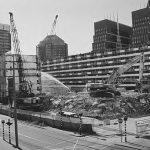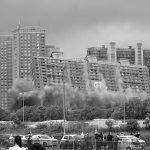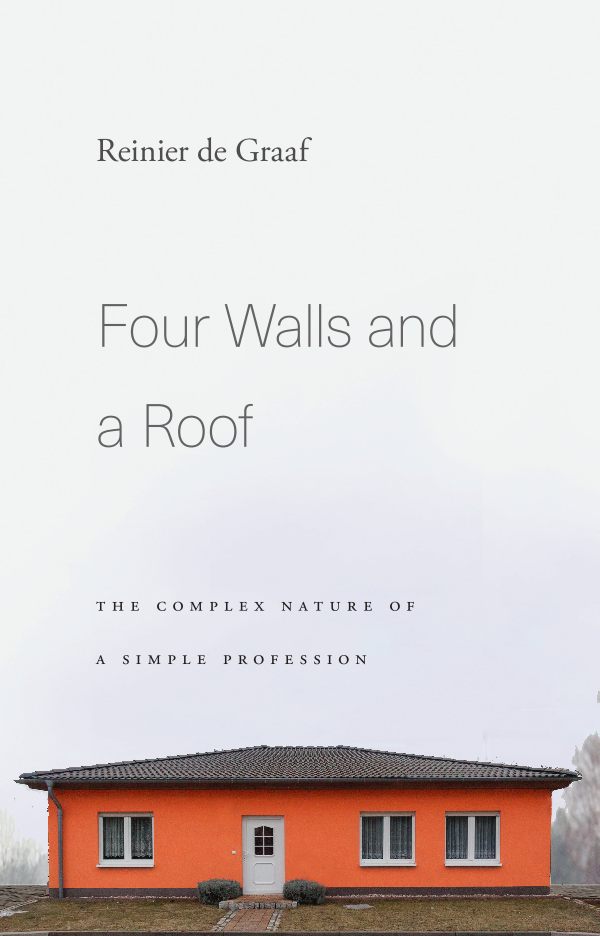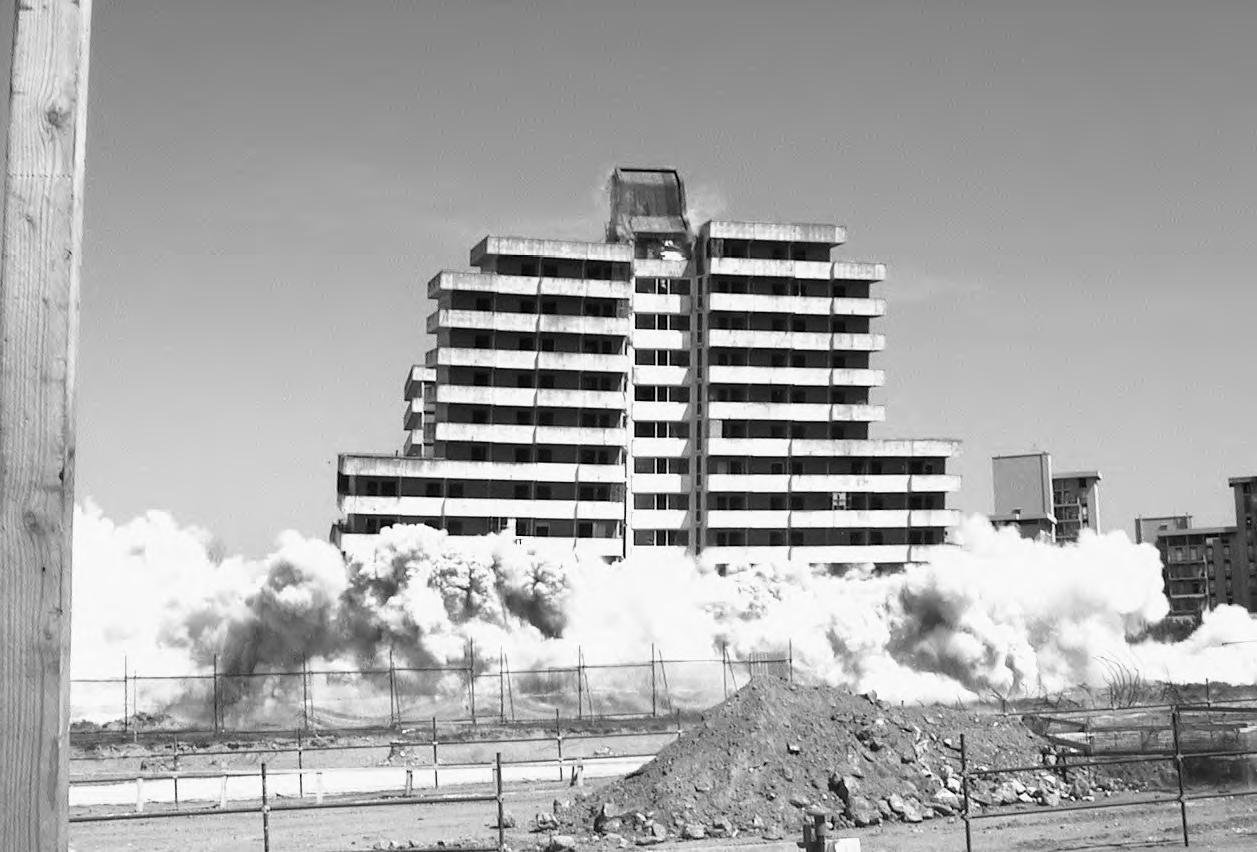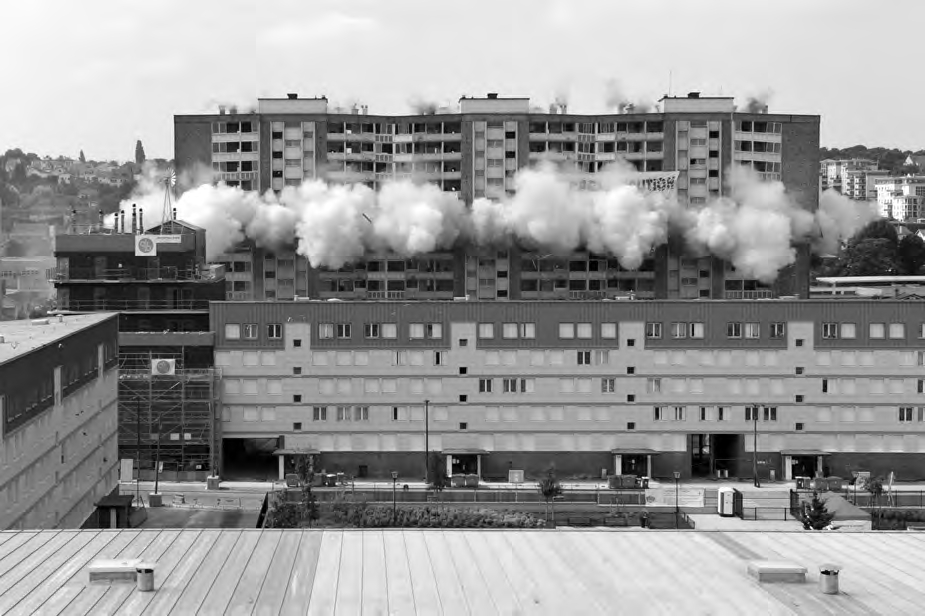Intro: Ștefan Ghenciulescu
“Four Walls and a Roof . The Complex Nature of a Simple Profession”. A book by Reinier de Graaf
Zeppelin rarely publishes “starchitects”. And when it does happen, it is mostly about an isolated project where, besides the fireworks (having their own value), there are also more important things: an (added) value as a public space, a smart urban transformation, beautiful spaces, innovation that will actually carry things on… Or because they express a phenomenon which needs to be critically discussed. Or, well, because it is what it is, and we all have our guilty pleasures.
As for the rest, we feel that Instagram architecture is so much alike blockbusters: they have their place, we all go see them, but the stronger they bloat, the more they start to look alike. And there is really little place left to add something to the avalanche of information and posts.
OMA are one of the exceptions to this rule: I must admit we continue to like them a lot. Yes, yes, we know: some sins, a lot of business… and a lot of PR. But even people who can’t stand them must admit they are always about something deeper than formal searches, language, splash. One cannot deny the research, the permanent innovation and the courage to deconstruct and reconstruct the most familiar things and ideas.
Oh, and there’s something else: true culture and how it is seen in projects, as well as spatial value (desperately imitated by a lot of copycats), and the slightly punk and subversive charm of best projects, even in the case of astronomical budgets.
Pretty much like in “Delirious New York” or “SMLXL”: I remember how, as ayoung architect, I would get mad (to various degrees) reading them, but I would also let myself carried away by incredible pleasure and sometimes enthusiasm. Some months ago, I visited the Kunsthal in Rotterdam again, and I can honestly say I still think it’s a masterpiece. Other things have changed: OMA is a big, really big company, dealing with big shots in politics and finance looks and can and must be judged otherwise than a group of enthusiasts in the ‘80s.
Yet, I believe that the mix of relaxed challenge, playfulness and critical innovation was preserved, while the team is almost completely changed. The multiplicity of the team and of the management has even started to show in a certain “regionalization” of projects, of which some even start to have an “Italian” or “American” feeling; or, in any case, to express the personality of the partner-in-charge.
Reinier de Graaf is a partner in OMA. An excellent practitioner: in Zeppelin #143 we published the “Timmerhuis” office and residential building in Rotterdam. Another project led by him was recently finished, namely the stage 1 of ”Norra Tornen” dwellings assembly in Stockholm. But we are now speaking of his book, “Four Walls and a Roof” a collection of essays on today’s architecture. Reinier de Graaf writes differently from Rem Koolhaas. Yet they share the absolutely remarkable knowledge, the curiosity, the humour and the merciless judgement. But I would say that Reinier de Graaf is prone to analysis rather than manifesto, to storytelling rather than aphorism. “The Complex Nature of a Simple Profession” is the subtitle of the book, one where we find several long stories on what today’s architecture means. Oligarchs, authorities, the financial world, blooming Neo-Liberalism, but also the (sometimes voluntary) suffocation of the ideals of modernity.
This is a page-turner, whether it is the “inside stories” or the careful, sad, and implacable analyses. It speaks of serious things, and it does it so well.
We are publishing here (thanks to Reinier and to Alexandru Retegan from OMA, who intermediated this relationship and who worked hard on the translation in romanian), a chapter of the book. It is “The Century That Never Happened”, an essay where Graaf parallels the disintegration of the welfare state and the disappearance of its architectural expression, the social housing estates.
We thought this text was really appropriate for the theme of the #156 issue of Zeppelin magazine- Accessible Houses. We found it even more relevant that it is not written by an ultra-leftist academic, but by a practitioner very much concerned with dwelling (but who cannot fail to notice how his older colleagues would work on social housing, rather than on luxury ones). The elimination of the physical substance of the modernist and social utopian dream (the very “bad” neighbourhoods of the ‘60s and ‘70s) is an actual expression of what Graaf suspects to be the very end of a period when capitalism had reached its most humane moment (in some places, at least). We have selected a few illustrations from a photo-essay in the book, which documents precisely that. We still hope he is wrong on the medium and long term, andthat the current enthusiasm for cooperative living, activism, etc., is not just a trend, but the sign of reinventing the alternative to the “pure market”.
About the book
Publishing house: Harvard University Press
Cost: $35.00 / £25.95 / €31.50
ISBN10 067497610X / ISBN13 9780674976108
Publication Date: 09/25/2017
Hardcover / 528 pages / 160 x 230 x 40.64 mm / 861.83 g
Text from the chapter “The Century That Never Was” of the book Four Walls and a Roof.
In 2013 Thomas Piketty published his book Capital in the Twenty-First Century. [Thomas Piketty, Capital in the Twenty-First Century, trans. Arthur Goldhammer (Cambridge, MA: The Belknap Press of Harvard University Press, 2014; initially published in French as Le capital au XXIe siècle in 2013)] If Piketty is right, we can once and for all bury the illusion that the present economic system ultimately works in the interest of all and that its benefits will eventually trickle down to the poorest in society. Contrary to what every economist since Keynes has been telling us, the inequality produced by capitalism may not be a temporary phase that the system, left to its own devices, will overcome; rather, it is a structural and inescapable long-term effect of the system. Piketty’s analysis is exceedingly simple. He identifies two basic economic categories: income and wealth. He then defines social (in)equality as a function of the relation between the two over time and concludes that as soon as the return on wealth exceeds the return on labor, social inequality inevitably increases. Those who acquire wealth through work fall ever further behind those who accumulate wealth simply by owning it. Only in the three or four decades after 1945—following two world wars and under pressure from social unrest, revolutions, labor unions, and the daunting presence of a global alternative to the capitalist system in the form of communism—only during this unique capsule of time did ordinary laborers improve their economic standing faster than the owners of capital.
Whether the twentieth century was merely a brief escape from the otherwise unavoidable mechanism of a deeply fraught economic system remains to be seen. Much will depend on what happens next; the twenty- first century will determine the legacy of the twentieth. So far, the signs are not encouraging. Since the late 1970s, after the great conservative revolution that Reagan and Thatcher set in motion, the promise of accumulating wealth through work has steadily lost ground for all but CEOs and other economic celebrities. The fall of the Berlin Wall (generally claimed as a victory of that same conservative revolution) and, in its wake, the wholesale collapse of the Communist bloc have exacerbated this trend. If current indicators are right, we could soon be faced with a situation where, for the first time since the end of the nineteenth century, returns on wealth through ownership will again exceed those of labor.
Indeed, if Piketty’s argument holds true, the twentieth century will have been no more than an anomaly, a brief interruption in the systemic logic of capitalism, in which the inherent accretion of capital through capital remains an unbreakable cycle. This simple economic conclusion may have social and cultural implications beyond our wildest imagination. When a lifetime of labor can no longer match the returns on an acquired fortune, inherited wealth once again becomes the defining factor of class distinction, reducing any notion of social mobility to a remote possibility at best.
If the twentieth century really was an anomaly, then perhaps so were its ideals; an entire period characterized by an enlightened belief in progress, social emancipation, and civil rights can be retroactively discarded as a fleeting moment of self-delusion—no more than a footnote in the long course of history. For the generation currently in a position of power, raised and educated in the twentieth century, this is difficult to acknowledge. For them, the moral imperatives of the twentieth century are beyond question, irrespective of political choices. (Even the most ardent supporter of the current free-market economy probably believes that the system ultimately acts in the interest of all rather than explicitly sup- porting the notion of extreme inequality.) The current generation, whether Left or Right, has not (yet) had its faith in the great emancipatory mechanisms shaken in any way. It is all they know and all they have ever known.
I was born in the Netherlands in 1964, started primary school in 1970, and graduated from university in 1988, one year before the fall of the Berlin Wall. I received eighteen years of public education, during which the notion that one progressed through study and hard work was firmly in- stilled. One earned one’s rights and did not inherit privileges. Education was received on the proportional basis of one’s talents, not the size of one’s wealth. We lived in the conviction that despite cultural and religious differences, Protestant and Catholic alike—there was no sizable Muslim population yet—would eventually merge into a single middle class. The absence of a poor underclass was generally interpreted as the logical consequence of the (apparent) absence of an upper class. Insofar as we were aware of an upper class, in no way did we have to reckon with or even acknowledge it. Sure, we had a monarchy, but even its implication in an occasional corruption scandal in no way shocked our faith in its absolute irrelevance. Monarchs were a symbolic necessity, there to represent the unity of a nation that in every other respect was getting by without them. Power was in the hands of an elected government, independent of our royal head of state. [It was not until much later, when Dutch Greenpeace activists were mysteriously released in Russia after a visit of the Dutch king and queen, that I realized that things were perhaps not that straightforward. -(The crew of the Arctic Sunrise, under the Dutch flag, November 2013. – see “Greenpeace Arctic Sunrise Ship Case.” )] Wealth existed, but it did not guarantee a right to power, nor should it. Our leaders were chosen by us, for us, and from us.
If Piketty is right, those self-evident truths may well have been based on quicksand. The many blessings of a life in the later twentieth century, particularly in Western Europe were not the natural outcome of a progressive evolutionary process but the result of a short-lived and unsustainable suspension of the real fate dictated by its contemporary economic system. Only under severe (political) pressure did capital refrain from showing its true face. In that context, Western Europe got a good deal: it was protected by American intolerance of communism but threatened—or savvy—enough to maintain a generous welfare system, dissuading its citizens from entertaining any real Communist sympathies. With the dissolution of the Communist bloc, much of that threat is now gone, and the economic trends of most European countries since 1989 speak loudly: cuts to welfare, the erosion of pensions, the reduction of public services, and so on.
Although my training as an architect might make me utterly unqualified to comment on Piketty’s economic theories, I cannot help but notice the resonance between Piketty’s narrative of “economic history” and the context of my profession. If one studies the history of architecture, and particularly that of the twentieth century, a striking confluence emerges between what Piketty identifies as the period of great social mobility and the emergence of the modern movement in architecture, with its utopian visions for the city. From Le Corbusier to Ludwig Hilberseimer, from the Smithsons to Jaap Bakema: after reading Piketty, it becomes difficult to view the ideologies of modern architecture as anything other than the dream of social mobility captured in concrete.
Let’s take a closer look. Until 1914 the returns on capital enjoy a comfortable lead over economic growth; from 1914 to 1950, the period of the great wars, that relationship reverses. (Piketty, Capital in the Twenty-First Century, 356, fig. 10.10) This period not only signifies a turning point economically but also marks a major cultural shift as the time during which the great modernist visions emerge. Shortly before the outbreak of World War I, the Futurist manifesto is published in Le Figaro.(Filippo Tommaso Marinetti, “The Futurist Manifesto,” first published as “I Manifesti del Futurism” in the Italian newspaper Gazzetta dell’Emilia on February 5, 1909, then in French as “Manifeste du futurisme” in Le Figaro on February 20, 1909) The spirit in which it is written is one of a deliberately reckless and unconditional embrace of the new. The manifesto glorifies speed, machinery, and violence as the dawning of a new era. In announcing great crowds excited by work, pleasure, and turmoil, it describes the Russian Revolution before it happened. (“Futurist Manifesto,” Article 11. ) The Futurists insist that “man will not be overtaken by progress, but instead Man will absorb progress in its evolution . . . reacting against the potentially overwhelming strength of progress, and shouting out his centrality.” (“Manifesto of Futurism”) This “triumph of the will,” more than the nationalism with which it is generally associated, is a definitive reckoning with the laissez-faire of nineteenth-century Italy and the lethargy of its ruling class, to be abolished in favor of cultural rejuvenation and an aggressive modernization.
A belief in the promises of modernization continues to dominate much of the rest of the century and results in a curious alternation between brutal industrial wars and utopian blueprints, the latter of which hope to deploy the ensuing maelstrom of industrial development for the greater good. In this respect there is a clear resonance with Piketty’s book, which observes a close relationship between the progress made during the twentieth century and the upheavals that went with it, noting that somehow no manifestation of the new ever unfolds without unsettling old vested interests and established relations of power. The great visionary actors in architecture—from the Futurists to the Constructivists, from CIAM to Team 10, from the Metabolists toArchizoom—invariably seemed to have coupled their embrace of the new with a need to settle scores with (that is, destroy) the old. Despite its mostly social(ist) mission, there is an element of unabashed cruelty in the depiction of the “city of tomorrow,” with its repetitive, industrially produced housing blocks and oversized infrastructure systems. Good intentions are dressed up in harsh vestments, as if to convey the brutal truth that progress comes at a price.
Piketty has been viewed as a Marxist. This is wrong. Where Marx saw social relationships and class struggles, Piketty sees only economic categories: wealth and income. Marx envisaged proletariat rule through revolution; Piketty’s description of the system is rather apolitical. Indeed, if Piketty’s analysis is at all political, it is only because he recognizes the power of political choices in curbing capital’s natural tendency toward inequality, which is best hindered by ongoing political opposition. In this view, the emancipating achievements of the twentieth century owed their existence largely to a contest between opposing political camps and would last only as long as victory for any one party is suspended.
Thus the concept of struggle moves to the center, not as a conflict between social classes but as a form of necessary agonistic pressure on the system, perhaps even an indispensable part of it, one that can never relent if the system is to remain fair. “Except in struggle, there is no more beauty,” wrote the Futurist Filippo Tommaso Marinetti, followed by “No masterpiece without an aggressive character.” (“Futurist Manifesto,” Article 7) Again, an interesting echo of the modern movement emerges. Modern architecture is invariably considered to be political, but by and large its political life has proved promiscuous. Italian Fascists sponsored modern architecture, as did Communists until Stalin. Le Corbusier served both the USSR and the Vichy regime. It is mostly in a desire to overthrow the old that commonalities between these systems can be found: a shared belief that whatever the consequences of action are, the consequences of inaction would be greater. In hindsight, then, the social mobility of the twentieth century becomes not a victory of the Left over the Right but of new over old: a cleansing of the existing social order in the name of leveling the playing field. Maybe that is the main idea encapsulated, albeit strangely, in the choice posed by Le Corbusier’s “Architecture or Revolution,” which presents architecture as a way to prevent violent revolution, embodying an ideological revolution in itself . (Le Corbusier, Towards a New Architecture, trans. Frederick Etchells (London: Butterworth Architecture, 1989), 269. “Architecture ou révolution” was the original title of “Vers une architecture.”) Despite all the hallmarks of leftist rhetoric, somehow this slogan proposing that architecture replaces politics remains apolitical. Political oppositions dissolve in a battle between new and old—in a choice between progress and regress.
The resonance of Piketty’s historical analysis of capital with the progression of architectural history is eerie at times. The first intersection (economic output exceeding the returns on capital) just before World War I clearly coincided with the emergence of the avant-garde, but the resonance also applies through more subtle distinctions within the twentieth century. From the early to the mid-1970s, for the first time in the twentieth century, the lead of economic output over the returns on capital begins to diminish, and toward the end of the 1970s a dif-ferent political wind begins to blow. The conservative revolution first sweeps the United States and later Europe, forcing an agenda of economic liberalization and the slashing of government spending. The size of the public sector is steadily reduced, and large public housing projects become a thing of the past. This period essentially and concurrently marks the end of an unfettered belief in the merits of modern architecture. In 1972 the Pruitt-Igoe public housing estate in St. Louis is demolished, an event that critics generally herald as the “end” of modern architecture and, on a larger scale, the end of modern utopian visions for the city. After the demolition of Pruitt-Igoe, confidence in the architectural profession is severely shaken. The mood becomes pensive; the seminal works of architecture are no longer plans but books, no longer visions but reflections. It is telling that the most noteworthy architectural manifesto of 1989, the year of the fall of the Berlin Wall and the onset of an uncontested global rule of capitalism, is A Vision of Britain by Prince Charles. The modern age prefigured in the Futurist manifesto, at the tail end of the Ottocento with its hereditary hegemonies, ironically concludes with an antimodern manifesto written by a member of the British royal family.
If the egalitarian climate of the 1960s and 1970s had made top-down modern architecture generally unpopular, the neoliberal policies of the 1980s and 1990s make it obsolete. The initiative to construct the city comes to reside increasingly in the private sector. “Thought production” by the architectural profession, in the form of theoretical manifestos or wholesale urban visions, gradually comes to a standstill. The form in which the city is constructed changes. Large interventions in the city, using public housing projects as the texture from which to compose a new and alternative urban fabric, become virtually impossible.
As part of a wholesale privatization program, public housing associations are privatized, and home ownership rises dramatically. By transforming large numbers of people from tenants into home owners, the prevailing powers also hope to garner political sway. As soon as people own their homes, a mortgage will give them a vested interest in keeping interest rates and inflation down. Locked into an inescapable financial reality, they will have little alternative but to sympathize with the economic agenda of the Right. Home owners—so the reasoning goes—will form an instantaneous conservative constituency.
Over the decades to come, however, the new allegiance between the middle class and the Right turns out to be a marriage of inconvenience. The conservative revolution had relied on two pillars: the endless rise of property values (to maintain the desire for home ownership) and wage moderation (to maintain the economy’s competitive power). It was matter of time before they would clash, exposing the whole system that allowed people to buy in as a Faustian pact. With property appreciating in value more than incomes rose, homes became ever more unaffordable; each generation of buyers suffered from the price increases that guaranteed the first owners profit.
Piketty’s observations about the power of returns of wealth over income are clearly manifested in real estate narratives of the past decades.
Real estate is a prime example of how capital, after a first wave of seeming to work to people’s advantage, inevitably acquires a worrying dynamic of its own. Over time, the basic possibility of owning one’s home becomes progressively beyond the reach of more and more people.
After the conservative revolution, the built environment and particularly housing acquires a fundamentally new role. From a means to provide shelter, it becomes a means to generate financial returns. A building is no longer something to use but something to own (with the hope of increased asset value rather than use value over time). Through the general deployment of the term “real estate,” the definition of the architect is replaced by that of the economist. This is also the moment at which architecture becomes definitively inexplicable (at least by the criteria according to which architects usually explain architecture). The logic of a building no longer primarily reflects its intended use but instead serves mostly to promote a generic desirability in economic terms. Judgment of architecture is deferred to the market. The architectural style of buildings no longer conveys an ideological choice but a commercial one: architecture is worth whatever others are willing to pay for it.
Architecture and marketing become indistinguishable, leading to a curious reversal of the process: computer renderings precede technical drawings, the sale of apartments precedes their design, the image precedes the substance, and the salesman precedes the architect. Perhaps Aldo van Eyck’s famous tirades against postmodernism in the 1980s were nothing more than an expression of desperation or indignation that somehow our work had been hijacked.
Indeed, if we take the Piketty analogy to its full conclusion, we may wonder whether there was ever such a thing as postmodern architecture at all. Perhaps what we witnessed was not a succession of architectural styles engaged in mutual polemics but a shift toward a fundamentally different role of buildings. If before the 1970s (roughly speaking) buildings were primarily regarded as (public) expenditures, after the 1970s buildings became mostly a means of revenue, a shift that caused further downward pressure on construction budgets. Once buildings are discovered as a form of capital, they can operate only according to the logic of capital. In that sense there may ultimately be no such thing as modern or postmodern architecture, but simply architecture before and after its annexation by capital.
Recent decades have seen the emergence of a new sobriety, a new modernism, at least in aesthetic terms. But how modern is the modern architecture of today? Modernism had a rational program: to share the blessings of science and technology universally. Recent decades have shown that modern architecture can easily be deployed to work against its original ideology. Once buildings are identified as a means of return, modern architecture’s economy of means is no longer a way to reach the largest number of people but a way to maximize profits. The same repertoire of rational production, incorporation of industrial products, celebration of the ninety-degree angle, and aesthetics of sobriety that once made buildings affordable now make buildings cheap. Marketing plays a crucial role here. Once modernism can freely be reinterpreted as a style rather than an ideology, it becomes relatively easy to dissociate a high selling price from a low cost base and reap record profits as a result.
Ironically, this development affects both rich and poor. When sale values exceed production costs to the extent they now do, the quality of a building is no longer judged by its physical or aesthetic attributes but by its potential to sell for profit. The whole notion of physical luxury is superseded by a value on paper. However, the value on paper in no way represents the real material value of the product. The price of property is created by a combination of size and location. Unless major technical flaws come to light, the material or technical quality of buildings barely plays a role. As long as the hype continues, the investment is safe.
A small anecdote: in 2016, in one of the wealthier boroughs of Central London, a high-end residential project was completed, consisting of some fifty luxury apartments. The legal obligation under London planning policies to realize a percentage of the apartments as affordable homes has been met by offering an alternative site in a somewhat poorer neighborhood some distance from the development. The project is targeted at the expatriate market, broadly known to settle purchases in cash, without a bank loan. Sales go more quickly that way. The cheapest apartment in the project costs £11 million. (The price of the most expensive apartment remains privileged information between the buyer and the developer, covered by a confidentiality agreement.)
The sales brochure speaks of “a rare place to live, in and around outstanding modern architecture in a park.” For quite a few of the prospective residents (rich Russians, perhaps), the idea of modern architecture in a park will evoke memories of a system whose collapse funded their personal fortunes. The architects are rumored to have considered weather resistant cardboard as a facade material, underlining the supreme irony of asking some of the world’s richest people to pay record prices for a cardboard box. The client, an old hand in the development business, has remained unfazed by the irony and has allowed the project to proceed, albeit on condition that there be a “slight change” in facade material.
Despite its aesthetics of poverty, the building is already substantially over budget. By coincidence, the surveyor releases his report (urging major cost cuts) the same day the estate agents release their list of buyers: an interesting collection of superwealthy Americans (many with Dutch surnames), Russian oligarch-billionaires, and Arab oil sheikhs. The poorest of the prospective buyers is worth a little over £2 billion, about fifty times the project’s construction budget. To ensure that “finances will add up,” the cost of the project is subsequently cut by 40 percent.
This anecdote, despite some of its farcical aspects, is symptomatic of overheated residential markets such as Central London, where even record prices paid by astronomically rich residents do not prevent downward pressure on construction costs. Meanwhile, the upward trajectory of residential prices created by the expatriate market has had a predictable effect at the other end of the spectrum in forcing moderate-income groups to live ever farther from the center. Nurses, teachers, policemen, firefighters, and other professionals earning moderate wages no longer qualify for mortgages for even the most modest properties inside Central London. The fire sale of council property in Central London boroughs, supposedly created to enlarge the stock of affordable homes, has done little to mitigate the process. After the first generation of tenants is offered the opportunity to purchase their rental apartments at subsidized rates, the next round of sales quickly conforms to market rates, generally making the apartments unaffordable for the income groups for whom they were originally intended. Even a well-intended piece of architecture, with all the right references to the enlightened modernism of the twentieth century, cannot avoid becoming an accessory in promoting an ever-widening gap between value and quality, a downward spiral where ultimately even the happy few get shortchanged.
Trellick Tower, a thirty-one-story building with 217 flats in North Kensington, built in 1972 and very familiar to architects, long had a reputation for antisocial behavior and crime. When “right-to-buy” council homes were introduced in the mid-1980s, many of the flats were bought by the tenants. A new residents’ association was formed, and several security improvements were undertaken, including the employment of a concierge. After the buildings’ Grade II* listing in 1998, property prices rose sharply, and flats in the tower came to be regarded as highly desirable residences. Despite serious technical problems within the building, properties inside the tower have sold for between £250,000 for a small one-bedroom flat and £480,000 for a fully refurbished three-bedroom flat. The maximum obtainable mortgage on an average annual gross income of £32,188 in the United Kingdom in 2014 was £152,000.
Central London is not the only place affected by this phenomenon. The Park Hill Estate in Sheffield, North Yorkshire, a council estate built in 1957, went into decay in the 1970s. (The estate was designed by Jack Lynn and Ivory Smith) In 1998 the complex was Grade II* listed, and English Heritage, together with a private developer, launched a renovation scheme to turn the flats into upmarket apartments and business units. (The renovation was one of the six shortlisted projects for the 2013 RIBA Stirling Prize.) According to Sheffield’s website, the city has “the lowest annual average salary of UK’s core cities” at around £24,000, allowing a maximum mortgage of around £115,000. Outside the United Kingdom, the original units of Le Corbusier’s Unité d’Habitation are currently being sold for €151,000 (for a thirty-one-square-meter studio), €350,000 (for a three-bedroom flat), and €418,000 (for a four-bedroom flat). The average annual wage in France is €30,300, allowing a maximum mortgage just under €120,000. The existenzminimum: the establishment of a universally acceptable minimum standard of living in the twentieth century seems to have become a privileged condition in the twenty-first.
The twentieth century taught us that utopian thinking can have precarious consequences, but if the course of history is dialectic, what follows? Does the twenty-first century mark the absence of utopias? And if so, what are the dangers of that? Piketty’s framing of the twentieth century echoes the familiar notion of “the short twentieth century,” the historic period marked by a global contest between two competing ideologies, running from the beginning of World War I to the end of communism in Eastern Europe—starting in Sarajevo, ending in Berlin. [The term “short twentieth century,” originally proposed by Iván Berend (Hungarian Academy of Sciences) but defined by Eric Hobsbawm, a British Marxist historian and author, refers to the period between the outbreak of World War I and the fall of communism in Eastern Europe. Eric Hobsbawm, Age of Extremes: the short twentieth century, 1914–1991 (London: Abacus, 1995), 3.] If we are to believe Piketty, we may well be on the way back to a patrimonial form of capitalism. With that, modern architecture’s social mission—the effort to establish a decent standard of living for all—seems a thing of the past. Once more, architecture is a tool of capital, complicit in a purpose antithetical to its one-time ideological endeavor. Nearly twenty years into the new millennium, it is as though the previous century never happened. The same architecture that once embodied social mobility now helps prevent it. Despite ever-higher rates of poverty and homelessness, large social housing estates are being demolished with ever-greater resolve. Perhaps Piketty’s theory, the final undoing of the twentieth century, finds concrete proof in the methodic removal of its physical substance.
Photos: Info & credits
1. Pruitt-Igoe, St. Louis, 1954–1972 / Photo: Lee Balterman / The LIFE Images Collection / Getty Images
2. Sutter Housing Project, New York City, 1955–1987 / Photo: David Rentas / New York Post Archives / © NYP Holdings, Inc. / Getty Images
3. Vela H, Napoli/Naples, 1974–2003. Courtesy of SIAG SRL—www .esplosivi
.
4. Marzahn, Berlin, 1977–2004 / Photo: Bernd Settnik / Picture-Alliance/ © ZB–Fotoreport
5. Zwarte Madonna, The Hague, 1985–2007 /Photo: René van Harrewijn / Beeldbank Haags Gemeentearchief
6. Red Road Flats, Glasgow, 1964–2015 © Carol McCabe Photography
7/ Neubrandenburg Plattenbau, 1974–2016 /Photo: Stefan Sauer / © DPA / Picture-Alliance/ ZB
8. La Cité Balzac, Paris, 1967–2012 /Photo: Eric Feferberg / AFP / Getty Images




